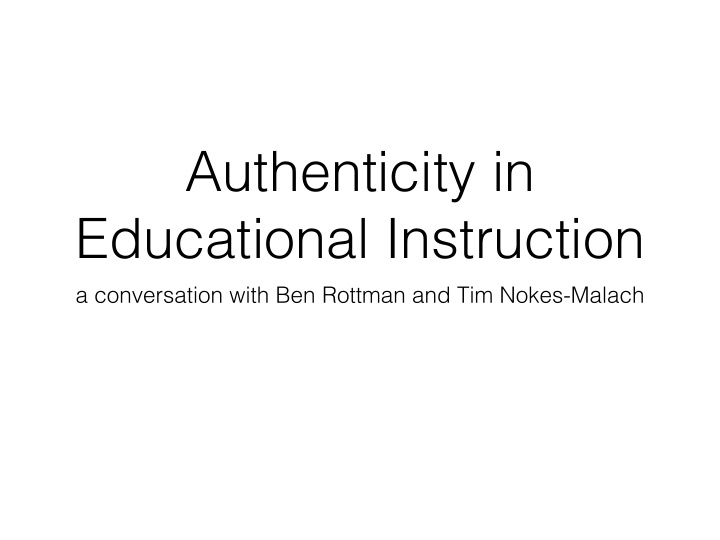



Authenticity in Educational Instruction a conversation with Ben Rottman and Tim Nokes-Malach
Outline • 10 minutes: intro to the topic • Ben: inspiration for a discussion • Tim: one proposal for a framework of authenticity • 15 minutes: Nancy Pfenning, Sam Donovan, Brian D’Urso, Sean Garrett-Roe, Nancy Kaufmann, Chris Schunn, others? • 5 minutes: summary of what we think authenticity is • 10 minutes: Why do we think that authenticity is important? What outcomes do we think it promotes? • 10 minutes: Should authenticity always be a goal, or only in certain classes? • Remaining Time: Challenges to making instruction authentic?
Brown Collins & Duguid, Situated Cognition and the Culture of Learning • Knowledge is not separable from the situations in which it is used • e.g., correlate - to be related to one another: “Me and my parents correlated because without them I wouldn’t be here.” • Conceptual knowledge is like a tool - can acquire a tool but not know how to use it (e.g., statistical test) • Learning requires enculturation (how to use the tools the way experts use them) through authentic activity. Authentic = ordinary practice of experts. • “Many of the activities students undertake are simply not the activities of practitioners and would not make sense or be endorsed by the cultures to which they are attributed. Consequently, success within [school] often has little bearing on performance elsewhere.” • Advocate for instruction as “apprenticeship”
Carl Wieman: Task Analyses of Experimental Science and Most Lab Courses • research question • deciding data to collect • feasibility analysis • design,construction, and verification of apparatus, stimuli, code etc. • get to collect data • choosing analysis method • get to do data analysis • determining what correct answer is • format for write-up (e.g., specific graphs) • significance and context • iteration
• Introduction to a culture? • Skills instead of knowledge? • Active instead of passive? • End-goal and/or process • actually doing real science or building something useful (e.g., SEA-PHAGES) • faithfully mimicking a process that scientists / industry experts perform but without a real end-goal • Promoting far transfer vs. making transfer less far • far transfer is easier because have practice with multiple, real, hard examples (e.g., reading multiple research articles -> transfer to new research article on different topic) • far transfer is not necessary because have worked with the target domain (e.g., internship in industry where you want to get a job)
Productive Disciplinary Engagement Engle, 2012
Productive Disciplinary Engagement Engle, 2012
Content Validity: “ The measure contains all the parts that your theory says it should contain.” Religious Commitment Inventory EXIT25: An Interview of Executive 1. I often read books and magazines about my faith. Function in Dementia 2. I make financial contributions to my religious 1. “What color are these letters?” RED organization. 2. Grasp reflex? 3. I spend time trying to grow in understanding my faith. 3. “1A, 2B, 3 what would come next? 4. Religion is especially important to me because it 4. “Remember these three words: BOOK, TREE, answers many questions about the meaning of life. HOUSE.”“Now spell CAT for me.”“OK, Tell me those 5. My religious beliefs lie behind my whole approach to three words we learned.” life. 5. “Now listen carefully. I want you to do exactly what I 6. I enjoy spending time with others of my religious say, Ready? Touch your ear.” (Examiner touches his affiliation. nose and keeps finger there.) 7. Religious beliefs influence all of my dealings in life. 6. Rooting reflex 8. It is important to me to spend periods of time in 7. … private religious thought and reflection. 9. I enjoy working in the activities of my religious organization. 10.I keep well informed about my local religious groups and have some influence in its decisions. Has: • Response Inhibition Has: • Working Memory • Guide to decision-making • Frontal Release Signs (primitive reflexes) • Social Missing? Missing? • Awareness of time and place • Belief in higher power • long-term memory
Reaction Time Explains IQ’s Homework Association With Death In Defense of Parenthood: Children Are Test Associated With More Joy Than Misery
Outline • 10 minutes: intro to the topic • Ben: inspiration for a discussion • Tim: one proposal for a framework of authenticity • 15 minutes: Nancy Pfenning, Sam Donovan, Brian D’Urso, Sean Garrett-Roe, Nancy Kaufmann, Chris Schunn, others? • 5 minutes: summary of what we think authenticity is • 10 minutes: Why do we think that authenticity is important? What outcomes do we think it promotes? • 10 minutes: Should authenticity always be a goal, or only in certain classes? • Remaining Time: Challenges to making instruction authentic?
Recommend
More recommend